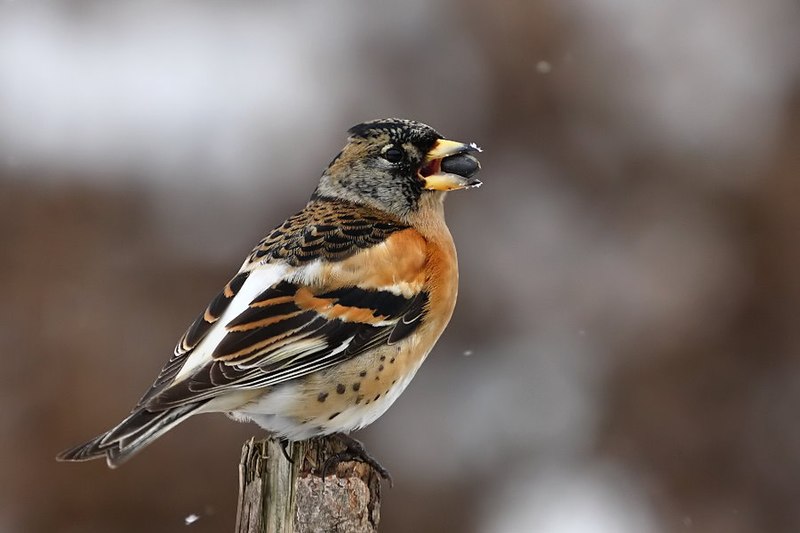
Brambling
Fringilla montifringilla
Order:
Family:
Size:
13.5-16 cm
Weight:
17-30 g
Taxonomy:
Linnaeus, 1758)
Short Description:
The brambling (Fringilla montifringilla) is a small passerine bird in the finch family Fringillidae. It has also been called the cock o' the north and the mountain finch.The brambling (Fringilla montifringilla) is a small passerine bird in the finch family Fringillidae. It has also been called the cock o' the north and the mountain finch. The brambling is similar in size and shape to a common chaffinch. Breeding-plumaged male bramblings are very distinctive, with a black head, dark upperparts, orange breast and white belly. Females and younger birds are less distinct, and more similar in appearance to some chaffinches. In all plumages, however, bramblings differs from chaffinches in a number of features: brambling has a white rump whereas that of chaffinch is grey-green, the breast is orange, contrasting with a white belly on brambling, whereas on chaffinch the underparts of more uniformly coloured (pink or buff), brambling's scapular feathers are orange, whereas chaffinch's are grey or grey-brown, the flanks are dark-spotted on brambling, plain on chaffinch. Bramblings lack the white outer tail feathers of chaffinch.An additional difference for all plumages except breeding-plumaged males is the bill colour - yellow in brambling, dull pinkish in chaffinch (breeding-plumaged male bramblings have black bills, chaffinches in the corresponding plumage have grey bills). This bird is widespread, in the breeding season, throughout the forests of northern Europe and Asia. It is migratory, wintering in southern Europe, north Africa, north India, northern Pakistan, China, and Japan. It regularly strays into Alaska during migration and may continue as far south as the western United States.[citation needed] The global population of bramblings consists in about 100 - 200 million birds, with a decreasing trend. Open coniferous or birch woodland is favoured for breeding. This species is almost entirely migratory. In Europe, it forms large flocks in the winter, sometimes with thousands or even millions of birds in a single flock. Such large gatherings occur especially if beech mast is abundant. Bramblings do not require beech mast in the winter, but winter flocks of bramblings will move until they find it. This may be an adaptation to avoid competition with the Chaffinch. Bramblings mostly eat seeds, but unlike most finches, their young are fed largely on insects.[citation needed] It builds its nest in a tree fork, and decorates the exterior with moss or lichen to make it less conspicuous. It lays 4–9 eggs. In Pakistan, Brambling is considered as common winter visitor throughout mountainous regions of western Pakistan, most numerous in Baluchistan. Often in flocks feeding in snow.
Far far away, behind the word mountains, far from the countries Vokalia and Consonantia, there live the blind texts. Separated they live in Bookmarksgrove right at the coast
Attock,Khushab,Rawalpindi,Karachi West,North Waziristan,South Waziristan,Abbottabad,Haripur,Chitral,Gilgit,Kalat,Khuzdar,Pishin,Quetta,Zhob,Ziarat
Bramblings exhibit typical finch behavior, often foraging for seeds and insects in forests and woodland areas. During breeding season, they build cup-shaped nests in trees or shrubs. In winter, they form flocks and can often be seen feeding on the ground or in trees, sometimes alongside other bird species. Their migration patterns in Pakistan coincide with the changing seasons, with sightings increasing during the colder months as they move to lower altitudes in search of food and milder weather.
Far far away, behind the word mountains, far from the countries Vokalia and Consonantia, there live the blind texts. Separated they live in Bookmarksgrove right at the coast
About Photographer : Hello World
Facebook
Twitter
Instagram
Flicker
LinkedIn


